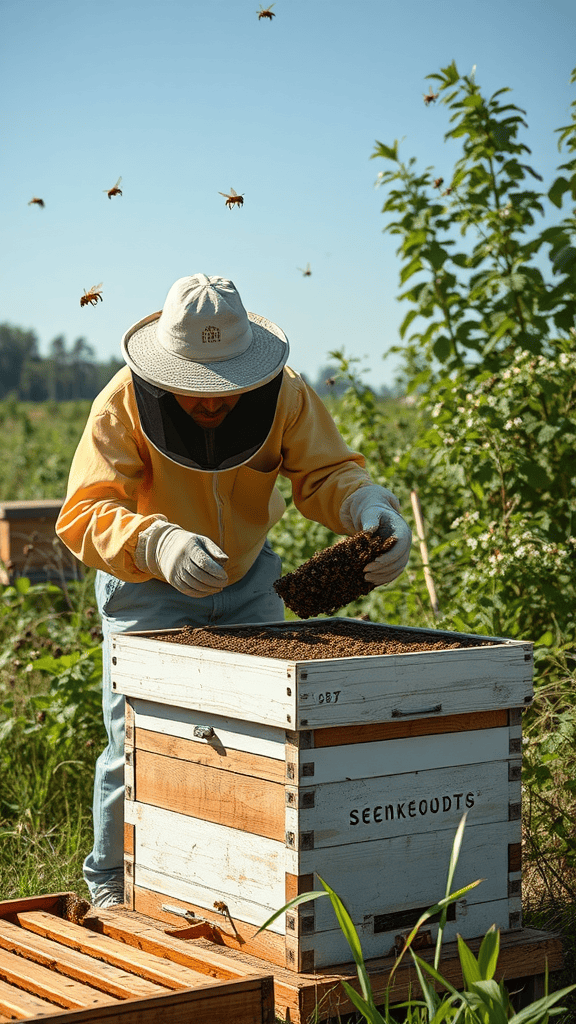Understanding the Basics of Skep Beekeeping
Skep beekeeping is an ancient method of maintaining honeybee colonies. It dates back hundreds of years and offers a glimpse into traditional beekeeping practices. Unlike modern hives, which are more widely used today, skep beekeeping relies on a simple dome-shaped structure made from straw or reeds. Understanding the basics of skep beekeeping can help you appreciate this time-tested technique while also exploring the importance of bees in our ecosystem.
The skep serves as a home for the bees, providing shelter while allowing them to carry out their natural behaviors. One of the most appealing aspects of this type of beekeeping is its organic feel. Many beekeepers who choose skeps are interested in sustainable practices, as skeps encourage bees to create their hives in a more natural setting.
Here are some of the key characteristics of skep beekeeping:
- Construction: Skeps are typically handmade from natural materials like straw, making them environmentally friendly. This construction method allows for good airflow and insulation while also blending in beautifully with the landscape.
- Shape: The traditional dome shape of a skep promotes a compact and safe environment for the colony. The design minimizes exposure to harsh weather while safeguarding the bees from potential predators.
- Colony Behavior: Bees in a skep can exhibit more natural behaviors, such as clustering and swarming. This is essential for the overall health of the colony, as it allows them to manage their temperature and communicate effectively.
As you delve deeper into the practice, you might wonder how skep beekeeping differs from modern hive methods. Understanding these differences can enrich your beekeeping knowledge.
- Harvesting Honey: In skep beekeeping, harvest time is less frequent and done with careful consideration. Unlike modern hives, where frames can be easily removed for inspection, a skep requires more finesse. Beekeepers usually wait until late in the season to harvest honey, minimizing stress for the bees.
- Monitoring Health: One challenge of using skeps is that it doesn’t allow for regular inspections. A lack of visibility into the hive means that beekeepers must rely on their instincts and knowledge of bee behavior to ensure colony health.
- Swarming: In skep beekeeping, swarming is more likely than in modern practices. Beekeepers must be prepared for this natural behavior, as bees may leave to establish new colonies if their current skep becomes overcrowded.
Choosing skep beekeeping requires proper preparation. If you decide to embark on this adventure, several fundamental aspects should guide you:
- Research: Familiarize yourself with bee behavior and skep construction techniques. Understanding how to craft a quality skep is vital for beginner beekeepers.
- Location: Select a suitable location for your skep. Bees require a sunny spot for warmth but also need shade during peak heat. Ensure the area has flowering plants nearby to provide adequate food sources.
- Community: Connect with local beekeepers or join a beekeeping group. Engaging with experienced beekeepers can provide valuable insights and support as you develop your skills.
In addition to harvesting honey, skep beekeeping can promote local ecosystems. By supporting bee populations, you contribute to biodiversity and pollination, which are vital for many plants and crops. As awareness grows about the decline of bee populations, practices like skep beekeeping can help protect these crucial pollinators.
By adopting skep beekeeping, you can participate in a long-standing tradition while also cultivating a deeper connection with nature. With patience and dedication, this approach not only nurtures bees but also enriches your life with the satisfaction of sustainable living.
Skep beekeeping merges craftsmanship, passion for nature, and a commitment to sustainability. By understanding its foundations, you can embark on a unique journey that honors the past while promoting the health of future bee populations.
The Benefits and Challenges of Using Skep Hives
Skep beekeeping has a rich history, extending back to ancient times when honey and beeswax were cherished commodities. While today’s beekeepers often prefer more modern hive systems, skep hives still hold appeal due to their unique characteristics. This method of beekeeping is both challenging and rewarding, offering benefits that might entice hobbyists and traditionalists alike.
One major benefit of skep beekeeping is its simplicity. Skep hives are typically made from woven straw or cane, creating a natural and beautiful structure. These hives are easy to construct and require minimal materials, which can be particularly appealing for those looking to keep bees in a sustainable way. You can even create your own skep at home, allowing for a personal touch and connection to your bees.
The historical aspect of skep beekeeping also presents a strong allure. By using a skep, you connect with generations of beekeepers who have practiced this method. The traditional form of beekeeping emphasizes harmony with nature, allowing bees to exhibit their natural behaviors without the intrusion of modern equipment. This can result in a more authentic experience for a beekeeper who values natural processes.
Another significant advantage is the ability to produce honey. Though skep beekeeping doesn’t allow for easy honey extraction like modern hives, the process of harvesting is rewarding in its own right. You will often find that the honey produced is rich and flavorful. Many beekeepers who use skep hives enjoy the thrill of approaching the hive to gather honey through careful and respectful techniques.
However, it’s important to note that skep beekeeping does come with challenges. Managing a skep hive requires more skill and attention than modern hives. Skep hives do not allow for routine inspections, which can make it harder to monitor your bees’ health. This challenge tasks you with learning how to observe the bees’ behavior from the outside, which might not be straightforward for beginners.
Another difficulty is the limited ability to control swarming. In skep beekeeping, swarming is natural and often inevitable, leading to a loss of bees and honey production. Without modern bee management techniques, such as the use of queen excluders, swarms may leave the hive unnoticed. As a skep beekeeper, you must develop a keen eye for noticing when the bees are preparing to swarm, allowing you to intervene as best as possible.
Furthermore, the lack of insulation in skep hives can lead to challenges in maintaining the ideal temperature for bees during harsh weather conditions. Unlike modern hives designed for temperature regulation, skep hives are more vulnerable to temperature fluctuations. You’ll need to be mindful of the weather, taking precautions to protect your bees from extreme heat or cold.
In terms of production, skep beekeeping often yields less honey compared to more efficient hive systems. This may deter individuals who aim to produce large quantities of honey for sale. The honey harvested from a skep hive usually involves more time and effort due to its traditional extraction process. By understanding the limitations of skep hives, you can adjust your expectations accordingly and truly appreciate the process.
Despite the challenges, many beekeepers find skep hives to be a fulfilling endeavor. They teach patience, respect, and a deep connection to nature. If you are inclined to explore this art form, consider visiting workshops or seeking mentorship from experienced skep beekeepers, which can enrich your learning experience further.
It’s vital to consider your local regulations when engaging in skep beekeeping. Some areas have restrictions on beekeeping practices, and you’ll want to be informed to ensure you manage your hives legally and ethically.
Skep beekeeping presents unique benefits and challenges that differentiate it from more modern methods. The simplicity of construction, connection to history, and rich honey flavor make skep hives appealing. However, the challenges of swarm management and temperature control require careful attention and knowledge. As a skep beekeeper, you will discover not just the art of beekeeping but also the nature of balance between effort and reward.
Conclusion
As you delve into the world of skep beekeeping, it’s essential to grasp the foundational aspects that set this traditional method apart from modern practices. By understanding the basics, including the design and function of skep hives, you can appreciate the intricate relationship between the beekeeper and the bees. Skeps are often admired for their aesthetic appeal and historical significance, reminding us of the roots of beekeeping that have persisted through the ages.
However, like any beekeeping method, skep hives come with their own set of benefits and challenges. On one hand, they offer a rustic charm and a natural approach to beekeeping that many enthusiasts find rewarding. The method allows for a symbiotic relationship with the bees, promoting organic practices. On the other hand, the use of skeps poses challenges, such as limited monitoring and harvesting capabilities. Skeps do not lend themselves to easy hive inspections, which are crucial for maintaining bee health and managing pests.
Navigating the balance between the old and the new is part of the skep beekeeper’s journey. By weighing the benefits against the challenges, you can decide if this ancient method aligns with your beekeeping goals. Whether you choose to embrace skep beekeeping for its history or as a sustainable practice, it invites you to take part in a timeless craft that connects you to both nature and an age-old tradition. Embracing this journey can lead to a fulfilling experience, enriching both your life and the lives of the bees you cherish.
As an Amazon Associate, I earn from qualifying purchases.

